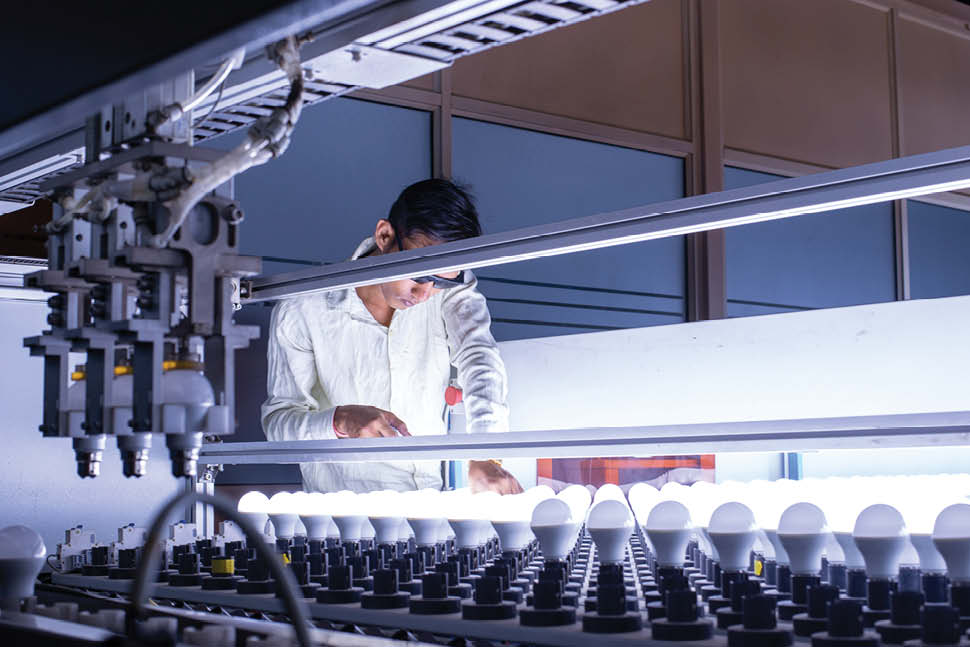
May 2022 / Vol. 27 No. 5
By Kelly Gordon, PNNL, and Morgan Pattison, SSLS, Inc.
It’s time to take stock of the light-emitting diode (LED) development journey and appreciate the breadth of products that now provide energy savings and more.
Significant gains in source efficiency of LED lighting products deserve recognition due to the massive energy savings they provide. At the same time, we need a new understanding of LED lighting technology’s potential to improve human and environmental health and well-being — from individual building occupants to the resiliency of buildings and infrastructure to climate impacts. Understanding and quantifying the full range of efficiency benefits from LED technology provides a more holistic vision for lighting performance and value.
The U.S. Department of Energy (DOE) Solid-State Lighting (SSL) Program proposes a new application-level approach that supports the delivery of the right amount of light at the right time, in the right direction, with optimized spectral properties for the functions of the light
This more holistic approach has prompted engagement with LED and lighting researchers and with architects, human physiologists, horticultural scientists, animal researchers, and others pursuing deeper lighting connections. DOE and its partners are rewriting the playbook, at times reimagining it for the next generation of lighting solutions where more intentional lighting design, new approaches to lighting controls, and innovative new products and tools will help us realize the full potential of LED lighting.
Intentional Lighting Design
One of several DOE research projects studying lighting in healthcare looked at senior care facilities in Wisconsin that operate in a 24-hour environment. The round-the-clock nature of senior in-patient care ranks it fourth in the U.S. in energy use intensity behind food service, hospitals, and grocery stores. Lighting systems represent the most extensive electricity end-use in healthcare.
A project by Pacific Northwest National Laboratory (PNNL) and Midwest Lighting Institute involved replacing fluorescent lighting with tunable LED lighting in two existing skilled nursing care centers to look at energy use impacts and occupant health. Results of the study suggest that technology choices, design strategies, and implementation considerations all play a role in energy savings and improved quality of life for senior care residents and staff. Following guidance from recent research findings, the highest-output and highest-CCT lighting (6500 K) operated between 10 a.m. and 3 p.m. when residents ate lunch in the dining room or spent time in the activity room. Shortly after dinner, the tunable lighting shifted CCT to a warm 2700 K, which provided a visual cue to residents and visitors that the day was winding down.
Equally important to providing certain lighting conditions during the day was designing an overnight lighting condition that allowed nursing staff to complete tasks while minimizing exposure to unnecessary lighting for residents who may be awake during the night. The switch to tunable LED resulted in more than a 60 percent lighting energy-use reduction due to higher LED system efficacies than fluorescent lighting and the ability to more precisely direct and dim the lights, offering energy savings and higher source efficiency.
Improving the Palette
Ongoing efforts to improve green LED efficiency have the potential to advance LED package efficiency even more while also enabling new features that can bring a vast range of new lighting application benefits. Green LED efficiency stands as the “weak link” limiting the use of color-mixed LED generation of white light. Current LEDs employ a phosphor conversion approach to white light generation. With the color-mixed approach, the maximum possible lighting efficiency can be higher. Full-color tuning is enabled to provide the right color of light for different application needs. DOE-funded research and development at Lumileds and the University of California, Santa Barbara (UCSB) for improving green LED efficiency is tackling fundamental materials science issues that currently limit green LED performance. We can achieve better efficiency and new application benefits from LED lighting with improved green LEDs.
Reimagining the Lighting Future
The new DOE L-Prize® competition aims to revolutionize lighting systems in segments that are the highest priority for LED adoption. The stated goal reflects the holistic lighting approach: “… LED lighting products manufactured with significant domestic materials, while demonstrating exceptional energy efficiency, data connectivity, seamless lighting control, excellent visual quality, and design for recycling and remanufacturing.” It also offers encouragement for environmental justice in design and implementation. The L-Prize confirms DOE’s belief that we’re closer to achieving advanced lighting systems that optimize the light while minimizing lighting energy use. The DOE announced the L-Prize Concept Phase winners recently, showcasing innovative visions of LED lighting systems. Future L-Prize phases will recognize high-performance prototypes and fully commercialized systems.
Science at the Foundation
Science is at the core of DOE SSL Program efforts to improve the efficiency and performance of lighting while also engaging new features offered by the technology. Materials science research exemplified by the UCSB and Lumileds projects advances a fundamental understanding of LED science while improving efficiency and enabling new lighting features. DOE-funded research at Virginia Tech and Thomas Jefferson University informs our understanding of physiological responses to lighting in practical applications. Color perception, flicker, and glare research at PNNL contributes to an understanding of ideal, efficient lighting for a given context and visual function. These projects and other R&D funded by the SSL Program continue to work toward improving light source efficiency and luminous efficacy while reducing cost and enabling new functions and features from lighting technology.
Kelly Gordon is team lead for Pacific Northwest National Laboratory’s Advanced Lighting Team and serves as PNNL program manager for the U.S. Department of Energy Solid-State Lighting Program.
Morgan Pattison is Senior Technical Advisor to the U.S. Department of Energy Solid-State Lighting Program and lead author of the DOE Lighting R&D Opportunities document. ei